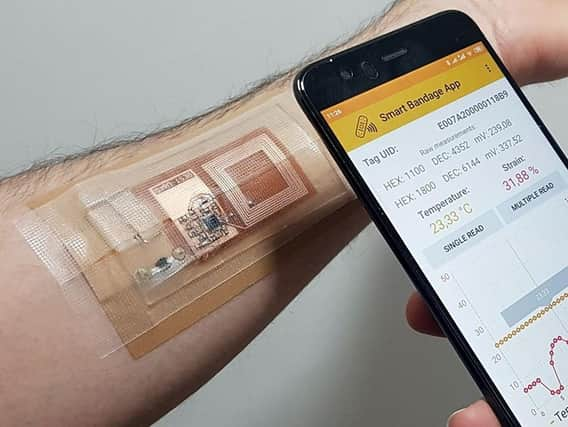Smart Bandages: Could they save lives and help us heal faster?


Which is why the ‘smart bandage’ concept currently being developed by the Bendable Electronics and Sensing Technologies (BEST) group at the University of Glasgow has the potential to make a significant impact. It uses different types of wearable sensors to capture accurate readings of a patient’s vitals and could enable more effective remote treatment. The flexible adhesive patch can apply the optimal pressure needed to accelerate wound healing by measuring the strain being put on the skin. With studies showing a body temperature of 35-38°C encourages wound healing, the bandage can also measure the patient's temperature and send readings to a healthcare provider via a smartphone app.
For example, patients with an open wound such as a bedsore or a foot ulcer will often need to be checked frequently. A smart bandage would allow a healthcare professional to monitor how well the wound is healing remotely. Temperature and strain are also two parameters that are rarely combined for wound assessment, making smart bandages one of the most innovative wearable devices to enter the healthcare industry.
Advertisement
Hide AdAdvertisement
Hide AdHowever, monitoring wound healing is not the only potential application; the bandage can also monitor breathing and even detect COVID-19 symptoms (including asymptomatic cases or COVID hotspots) and asthma. By placing a patch on a patient’s chest, the strain sensor can detect erratic breathing and monitor lung function. The smart app connected to the bandage can immediately notify healthcare professionals, who can speed up testing and treatment.
Some of these key applications have been tested in the lab but the BEST group is now exploring collaboration with clinicians to translate the device’s use into real practice, a process which takes a few years dependent on approvals.
There are obvious benefits to the use of smart bandages, but we must also accept that these are incredibly technical devices. This means they require huge amounts of data, continuous analytic reporting, and improvements’ driven AI and machine learning. Of course, these processes will still rely on inputs from experienced clinicians to extract useful information from the data, but commitment to mass use of this device and sustained upkeep of the data infrastructure will be essential.
In future, this technology could help predict diseases and allow preventative treatment before they form—and improve their diagnosis—but having these clear aspirations will be essential as we navigate the important and complex developments in our sector.
Professor Ravinder Dahiya is Professor of Electronics and Nanoengineering at the James Watt School of Engineering at University of Glasgow and a Fellow of the Royal Society of Edinburgh. This article expresses his own views. The RSE is Scotland's national academy, bringing great minds together to contribute to the social, cultural and economic well-being of Scotland. Find out more at rse.org.uk and @RoyalSocEd